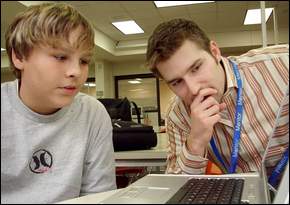Sioux Falls man counts on math game
Idea turns to reality for game-design classmates |
 Sioux Falls game designer Taylor Clark (right) shows his mentor student, T. J. Rarrat, 12, his math game Prime Time during their time together at Whittier Middle School. |
Creating a video game from scratch is challenging, but building one that
makes learning multiplication more fun for elementary and middle school students
sounds doubly daunting.
Sioux Falls game designer Taylor Clark has done
just that with his game “Prime Time,” an educational computer game that combines
times tables with puzzle games.
“What really caught my attention was
there are no fun math games out on the market,” says Clark, 24, of Sioux Falls.
“I looked at the games the student I mentor plays, and they were cartoons with
an equation, with no real game action.”
Clark turned to a friend from the
Seattle area, Ben Shirley. The two were classmates at DigiPen Institute of
Technology there, where they learned game design and programming.
“Ben
wanted to do it, and we both knew we wanted to make something on a professional
level, not just some Web-based game to throw up on a site,” he says. “We wanted
commercial-level code, but it had to be fun and kid-oriented.”
The duo
came up with “Prime Time,” a game that teaches players multiplication factors
while they try to keep a growing wall of boxed numbers from reaching the
opposite end of a field.
Numbers in black boxes appear on the screen, and
players have to find prime numbers in white boxes that, when multiplied
together, equal the targeted black boxes. For example, if a black box holds a
“6,” players will need to click on a “2” and a “3,” then the “6,” and then all
three boxes disappear.
“It was something I came up with when we were in
school together,” says Shirley, 24, of Bellevue, Wash. “Taylor did the coding,
and I did a lot of the design work.”
A big fan of puzzle games, Shirley
started with prime numbers and realized they could serve as the base for the
game. He also wanted to capture the spirit of simple games he loved as a child.
“I wanted a game that, with little or no instruction, you could start playing
and enjoy,” he says. “As you play ‘Prime Time,’ your skills improve. I got
better. We thought it would be a good way for students to improve, too, without
even realizing they are learning.”
The game is in the fine-tuning stages
and has several modes, including some that force players to concentrate on
addition skills. Clark says a multiplayer version would allow students, perhaps
working in an independent study period, to face off against other students
around the world, via the Internet.
“When I showed it to my mentee and
his friends, I told them to be honest; don’t be nice,” Clark says, referring to
the seventh-grade boys who did some testing for his game. “They were having a
ball and really doing well after about 10 minutes.”
T.J. Rarrat of Sioux
Falls says when he plays the game, the music, the graphics and the fun of it are
encouraging. Clark mentors Rarrat at Whittier Middle School.
“It’s like
‘Tetris,’ but you learn as you go, and I think it’s fun,” says Rarrat, 12. “When
I play it now, I know I have to divide and multiply to get the target
numbers.”
The game has enough action, with the creeping wall of numbers,
that Rarrat says he’s not thinking about math homework or practicing
skills.
“You have to know your numbers,” he says. “It makes you use your
math skills.”
Stephanie Spaan, owner of Excel Achievement Center in Sioux
Falls, overheard Clark talking about his game at a hair salon. “I was interested
because we’re always looking for higher-quality math programs,” she says. “He
brought in a demo version and showed me how it works.”
Spaan says the
game was fun, and she could see how it would fit into the education mix at
Excel. “Other games carry a larger variety of mathematics instruction, but this
is great for prime factors and multiplication,” she says. “Thus far, it’s
received very positive feedback.”
Clark hopes to market the game, but he
and Shirley realize they have work to do. The game would cost about $200 for a
school or agency, allowing them to make unlimited copies for multiple computers,
or about $15 for a single copy, they say.
“I’ve shown it to teachers at
Whittier and got some feedback, mostly positive,” he says. “We’d rather publish
it ourselves, but it’s too early to say what will happen. Ideally, we’d have it
ready to sell to schools and shop it around the country later this
fall.”
Reach reporter Jarett C. Bies at (605) 977-3925.

